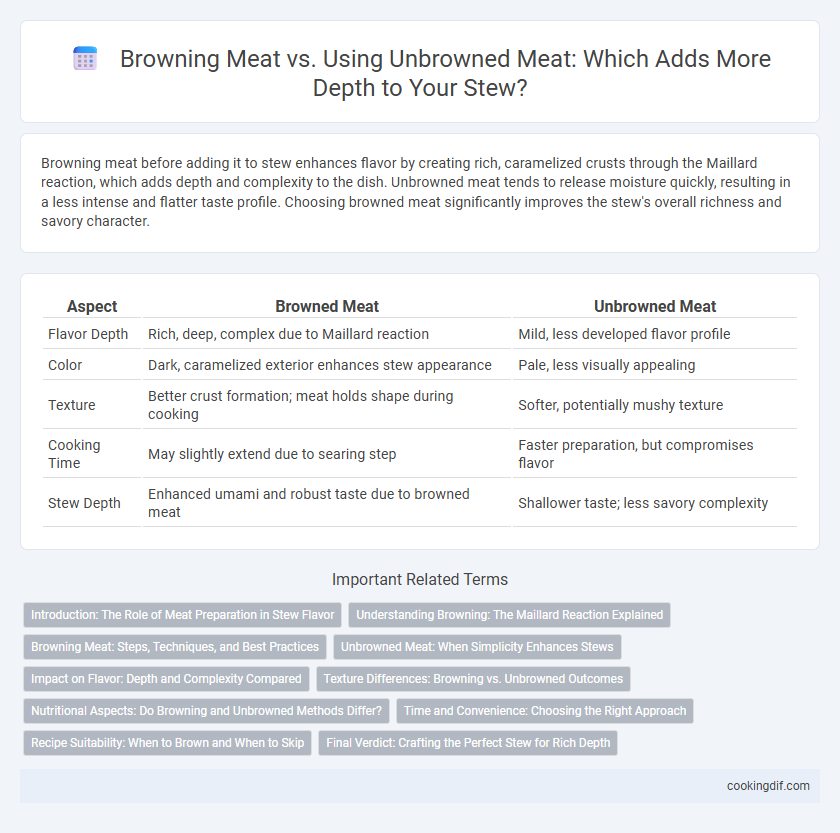Browning meat before adding it to stew enhances flavor by creating rich, caramelized crusts through the Maillard reaction, which adds depth and complexity to the dish. Unbrowned meat tends to release moisture quickly, resulting in a less intense and flatter taste profile. Choosing browned meat significantly improves the stew's overall richness and savory character.
Table of Comparison
| Aspect | Browned Meat | Unbrowned Meat |
|---|---|---|
| Flavor Depth | Rich, deep, complex due to Maillard reaction | Mild, less developed flavor profile |
| Color | Dark, caramelized exterior enhances stew appearance | Pale, less visually appealing |
| Texture | Better crust formation; meat holds shape during cooking | Softer, potentially mushy texture |
| Cooking Time | May slightly extend due to searing step | Faster preparation, but compromises flavor |
| Stew Depth | Enhanced umami and robust taste due to browned meat | Shallower taste; less savory complexity |
Introduction: The Role of Meat Preparation in Stew Flavor
Browning meat before adding it to stew enhances flavor through the Maillard reaction, creating complex, savory notes that deepen the overall taste profile. Unbrowned meat tends to release more moisture, resulting in a milder, less robust stew base. Proper meat preparation significantly influences the richness and depth of stew flavor, making browning a preferred technique for hearty, well-developed dishes.
Understanding Browning: The Maillard Reaction Explained
Browning meat for stew triggers the Maillard reaction, a chemical process between amino acids and reducing sugars that creates complex flavors and deep color, enhancing the stew's richness. Unbrowned meat lacks this reaction, resulting in a milder taste and paler appearance. Mastering browning unlocks deeper savory notes that elevate the overall stew experience.
Browning Meat: Steps, Techniques, and Best Practices
Browning meat for stew significantly enhances flavor by creating Maillard reactions that develop complex, savory notes and a rich, caramelized crust. Key steps include patting the meat dry, preheating a heavy-bottomed pan, and searing the meat in batches over medium-high heat without overcrowding to ensure even browning. Best practices involve using high-smoke-point oils like vegetable or canola oil, avoiding stirring too soon to form a proper crust, and deglazing the pan with broth or wine to capture all browned bits for deeper stew flavor.
Unbrowned Meat: When Simplicity Enhances Stews
Unbrowned meat in stew preserves its natural flavors, allowing the broth to develop a clear, clean taste that highlights the freshness of vegetables and spices. This technique simplifies preparation and accelerates cooking time, producing a lighter, more delicate stew profile ideal for subtle seasoning. Chefs seeking a stew that emphasizes broth clarity and ingredient authenticity often prefer unbrowned meat for enhanced depth without overpowering richness.
Impact on Flavor: Depth and Complexity Compared
Browning meat before adding it to stew intensifies flavor through Maillard reaction, creating deep, savory notes and rich complexity not present in unbrowned meat. Unbrowned meat results in a lighter, less concentrated broth with simpler taste profiles. The caramelized crust formed during browning imparts a robust umami character, enhancing the overall depth and mouthfeel of the stew.
Texture Differences: Browning vs. Unbrowned Outcomes
Browning meat before adding it to stew creates a Maillard reaction that enhances texture by forming a caramelized crust, resulting in a richer, more complex mouthfeel. Unbrowned meat yields a softer, less textured outcome, often leading to a stew with a milder flavor and less structural contrast. This textural difference significantly impacts the overall depth and sensory experience of the final stew.
Nutritional Aspects: Do Browning and Unbrowned Methods Differ?
Browning meat before adding it to stew enhances the Maillard reaction, increasing flavor complexity without significantly altering its macronutrient content such as protein and fat. Nutritionally, browned and unbrowned meat retain similar levels of essential amino acids and minerals like iron and zinc, though browning may cause minor nutrient loss due to surface heat exposure. Stewing browned meat can improve digestibility slightly by pre-cooking proteins, while unbrowned meat stewed for longer times yields comparable nutritional benefits through slow cooking.
Time and Convenience: Choosing the Right Approach
Browned meat enhances stew depth through the Maillard reaction, requiring extra time for searing but delivering rich, complex flavors. Unbrowned meat saves preparation time and simplifies cooking but may result in a less intense taste profile. Balancing cooking duration and flavor complexity determines the best method for stew preparation based on convenience and desired depth.
Recipe Suitability: When to Brown and When to Skip
Browning meat for stew enhances Maillard reactions, developing complex flavors and a rich, deep color ideal for hearty, slow-cooked recipes. Unbrowned meat suits lighter stews or fast-cooking dishes where tenderness and subtle meat flavor are prioritized over intensity. Selecting whether to brown depends on desired stew depth, cooking time, and flavor complexity.
Final Verdict: Crafting the Perfect Stew for Rich Depth
Browning meat before adding it to stew enhances the depth of flavor through the Maillard reaction, creating complex, savory notes that enrich the broth. Unbrowned meat results in a milder, less robust stew lacking the caramelized textures essential for a hearty profile. For the perfect stew, sear the meat first to develop a rich, layered taste that elevates the entire dish.
Browned meat vs Unbrowned meat for stew depth Infographic

 cookingdif.com
cookingdif.com